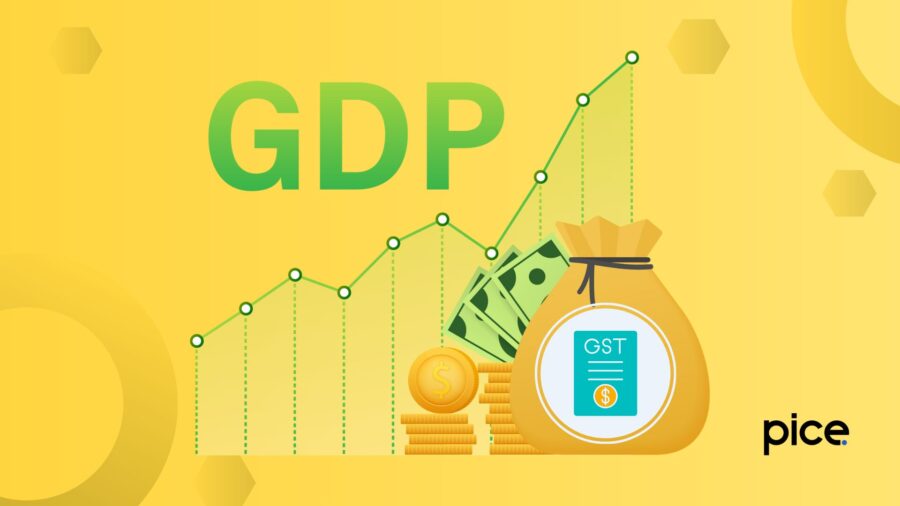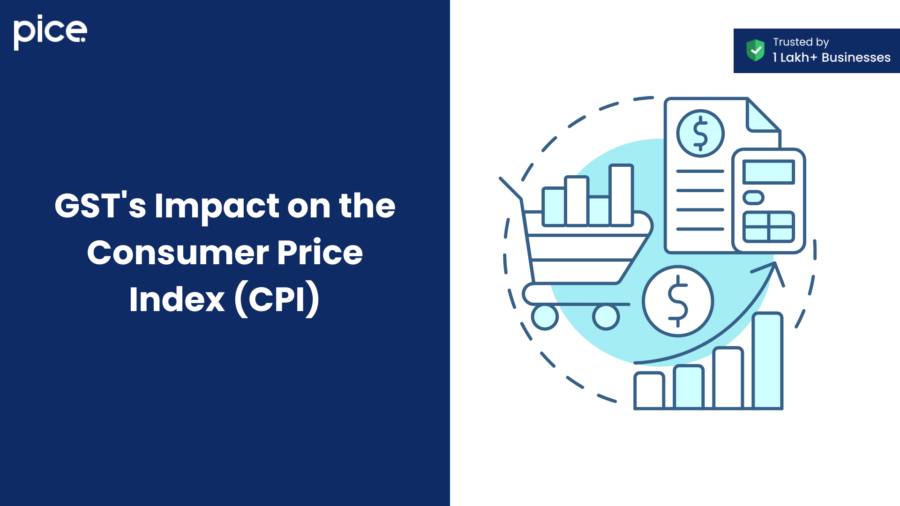GST and Its Effect on GDP
- 24 Sep 24
- 12 mins

GST and Its Effect on GDP
- What Is GST?
- GST Implementation in India
- Positive Effects of GST on the Indian Economy
- Negative Effects of GST on the Indian Economy
- GST's Impact on the Consumer Price Index (CPI)
- GST's Effect on the Common Man's Expenses
- Impact of GST on Different Sectors
- Short-Term Effects of GST
- Prospects for the Future
- The Bottom Line
Key Takeaways
- GST simplified India's tax structure by eliminating the cascading effect of multiple taxes.
- The introduction of GST boosted economic growth by facilitating interstate trade and reducing logistics costs.
- Compliance with GST has been technology-driven, improving tax transparency and collection.
- Small and medium enterprises initially faced challenges adapting to GST due to increased compliance costs.
- While inflation rose temporarily post-GST, the long-term economic outlook remains positive with increased exports and government revenue.
The implementation of the Goods and Services Tax has significantly influenced various sectors in India such as manufacturing, logistics, real estate and others, with widespread effects on the economy. Since Gross Domestic Product (GDP) serves as a key indicator of a nation's economic growth, we will walk you through the impact of GST on GDP to better understand India’s economic trajectory after GST came into effect.
What Is GST?
GST is an indirect tax that the government levies on the supply of goods and services. The consumer bears the tax burden of GST, eliminating the cascading effect of taxation in India. Prior to the introduction of GST, the Indian taxation system exhibited a double taxation system. GST implementation eradicated this effect, making it a unified taxation system.
GST Implementation in India
The Goods and Services Tax was implemented in India under the GST Act, 2017 with effect from 1st July 2017. It aims to follow a single and unified taxation system in the country with the objective of ‘One Nation, One Tax’.
India follows a dual GST model wherein both the Central and State Governments levy GST on the supply of goods and services. Supply of goods and services includes inter-state (between two states or union territories) and intra-state (within one state or union territory) supplies.
Based on the supply type, consumers pay CGST (Central Goods and Services Tax), SGST (State Goods and Services Tax) and IGST (Integrated Goods and Services Tax). The GST rates in India are 0%, 5%, 12%, 18% and 28% based on the type of goods and services supplied.
💡If you want to pay your GST with Credit Card, then download Pice Business Payment App. Pice is the one stop app for all paying all your business expenses.
Positive Effects of GST on the Indian Economy
Here are the positive effects of GST on the Indian economy:
- Simplified Tax Structure
Prior to GST implementation, the government levied multiple indirect taxes at different stages of product supply. This not only resulted in a double taxation system but also complicated the tax structure for taxpayers as they had to comply with various tax laws. GST introduction resulted in a single taxation system, reducing the complexities in tax structure and compliance laws in India.
- Enhanced Tax Compliance
The GST system is extensively technology-oriented and includes online registration, e-filing of returns and e-way bills. This has improved tax compliance by taxpayers and reduced incidents of tax evasion. Thus, the Indian government has been effective in increasing its tax revenues from registered taxpayers.
- Stimulus for Economic Growth
GST simplified interstate supply of goods and services with the elimination of entry tax at state borders. This reduced logistics costs, helping industries like manufacturing and logistics prioritise seamless interstate supplies. Further, GST has been effective in boosting Indian manufactured goods and their supply which contributed positively to the GDP (Gross Domestic Product - the element to measure economic growth) in India.
- Lowering the Tax Burden
GST, being a unified taxation system, eliminated the cascading effect of tax in India. As a result, the prices of goods and services reduced significantly. In addition, the Input Tax Credit mechanism helped taxpayers reduce their output tax liability, thereby lowering the tax burden on normal taxpayers.
- Formalisation of the Economy
The introduction of GST in India encouraged businesses to consider a formal tax system. This improved tax collection and openness in the economy, helping the government collect higher revenue from taxpayers. Further, reduced tax evasion contributed to an increased government revenue generation.
- Increased Competitiveness in the International Market
Exports from India are considered a zero-rated supply. In other words, the government does not levy taxes on exports from India. As a result, Indian goods exhibit an increased competitiveness in the international market. An increase in exports after GST significantly contributes to the GDP growth of the nation indicating prospective economic growth.
Negative Effects of GST on the Indian Economy
Here is the negative impact of GST on the Indian economy:
- Initial Challenges
Small and medium-scale businesses initially faced challenges in complying with GST laws and newly introduced standards. This created disruptions for these businesses following the implementation of GST.
- Compliance Challenges
Even though GST improved compliance in terms of adhering to a unified tax system, certain compliance challenges persisted among SMEs. For instance, businesses confronted challenges in terms of complex paperwork and GST reporting which impacted the Indian economy.
- Impact on Small Businesses
Small businesses confronted challenges with GST implementation as they enjoyed certain threshold exemptions on specific taxes earlier. Additionally, compliance costs for small businesses increased with the need for integrating technologies and professional services.
- Sectoral Disparities
While certain industries such as manufacturing and logistics reaped the benefits of GST, other industries such as the real estate and textile industries have been subject to challenges. The aforesaid industries encountered difficulties in adjusting to the newly introduced tax structure.
- Inflationary Pressures
GST resulted in a temporary inflationary trend in the economy wherein there has been an increase in the prices of goods and services. The increase in prices was due to the change in tax rates and categories. Consumer Price Index (CPI), which is the indicator of inflation, increased by approximately 1% after the GST introduction, affecting the Indian economy significantly.
GST's Impact on the Consumer Price Index (CPI)

Initially, when GST came into effect, the expected CPI was 3.24%. The government estimated that the purchasing power of consumers would increase due to the unified tax structure. However, the actual CPI was 4.61%, marking an increase of around 1.37%.
Despite an increase in CPI and inflation after the introduction of GST, it can be stated that there have been multiple positive impacts of the new indirect tax on the Indian economy. Thus, even though there was a significant rise in CPI in India in the post-GST era, the country's GDP growth has been positive, indicating steady economic progress.
GST's Effect on the Common Man's Expenses
While the post-GST era saw an increase in tax payments, it also brought several benefits for the common man. The commodity prices significantly decreased in the post-GST era due to reduced tax payable by the consumer goods producers in the FMCG (Fast-Moving Consumer Goods) and automotive sectors. As a result, the number of consumers availing services increased.
The price decrease is directly proportional to an increase in demand. Thus, the consumer goods producers could increase their profit margin. Increased production resulted in additional employment opportunities and an increase in income. This has been one of the prominent positive impacts of GST on the common man.
Additionally, as the GST introduction reduced tax evasion and money laundering practices, it helped the common man secure their money across the country. As a result, even though the tax payable by the common man increased, they can reap several benefits of GST implementation, contributing to the growth of the economy and GDP.
Impact of GST on Different Sectors
The following are the impacts of GST on different sectors like real estate, logistics, telecom and FMCG:
Real Estate:
In the pre-GST era, the Central Government levied service tax and the state government levied VAT (Value-Added Tax) on property construction. Further, developers could not claim input credit on service tax in the earlier tax regime.
However, in the post-GST era, the developers can claim the Input Tax Credit on purchased goods and services used for the construction of properties. They can use the claimed credit to pay output tax liability, reducing their tax burden significantly.
Nevertheless, as GST does not apply to completed properties, it can be understood that the impact of GST has been positive for the real estate sector. As this sector contributes around 7% to 8% to India's GDP, the positive impact has facilitated the economic growth of the nation.
Logistics:
The logistics sector has been beneficial after GST came into effect. GST implementation eliminated tax levied on the inter-state supply of goods, minimising interventions of tax authorities during goods transit. This additionally reduced the transportation time for a significant sector of the Indian economy.
The GST system introduced an e-way bill, eliminating paper documents for goods transportation. Besides reducing documentation needs, it helped reduce incidents of tax evasion, ensuring compliance with tax laws. The new tax regime imposes penalties for non-compliance with regulations pertaining to e-way bills. Thus, the strict norms helped the logistics sector reap multiple benefits.
Telecom:
The Indian telecom industry is the world's second-largest with billions of active users. This sector succumbed to challenges in the post-GST era with an increase in its tax rate from 15% in the pre-GST era to 18% after the GST introduction.
Additionally, the telecom sector purchases diesels which are exclusive of GST. As a result, this sector fails to claim an Input Tax Credit on the purchase of diesel, making it cost-intensive for companies operating in this sector.
FMCG:
The impact of GST on the FMCG sector has been positive. The implementation of GST reduced the logistics costs in the FMCG sector. Further, the tax rates prevailing in this sector are low, making it competitive in the operating market.
Short-Term Effects of GST
The post-GST era witnessed a higher tax payable by consumers as the tax rates on goods and services increased. In addition, the compliance cost increased for small-scale manufacturers and traders after GST implementation. As a result, small-sized businesses increased the prices of goods and services relatively compared to the pre-GST era. Thus, GST had a significant short-term impact on indirect tax rates and prices of goods and services.
Prospects for the Future
GST is likely to have multiple long-term benefits for the Indian economy. It not only aims for a lower tax rate but also minimum tax slabs. India has 5 tax slabs and 3 tax rates, namely the integrated rate, the central rate and the state rate.
Additionally, the government levies cess over and above the tax to collect revenue from taxpayers in India. In the medium term, the inflation rate will likely reduce in India as a significant macroeconomic impact of GST. This is due to the elimination of the cascading effect of tax.
Further, the revenue generated by the government will likely increase, reducing the fiscal deficit of the country. GST will likely result in a rise in exports followed by an increase in FDI (Foreign Direct Investment). Thus, this tax reform is likely to contribute positively to the growth of the nation's economy indicated by GDP growth.
The Bottom Line
The impact of GST on GDP has been significant and positive. India recorded prominent GDP growth, indicating economic growth after the implementation of GST. Even though there has been an increase in the inflation rate in the post-GST era, it will likely boost economic growth further in the long run. Thus, it is safe to say that the unified taxation system has effectively helped India at the macroeconomic level.
 By
By 

















